Essay: Managing Cultural Diversity in Australian Schools (NSW Program)
VerifiedAdded on 2023/01/23
|15
|3581
|87
Essay
AI Summary
This essay examines an initiative by the New South Wales (NSW) government in Australia aimed at managing cultural diversity within schools. It begins by providing background on the importance of cultural diversity and the government's response. The essay then details the program, including its strategies and objectives, such as fostering intercultural understanding, educating teachers, and ensuring equal participation of all students. The analysis relates the program to Verkuyten's social identity approach, highlighting strengths like the focus on teacher training and student awareness, and weaknesses such as the reliance on school and teacher cooperation. The essay concludes with recommendations based on the analysis, offering insights into improving the program's effectiveness in creating inclusive and responsive learning environments for a culturally diverse student population.
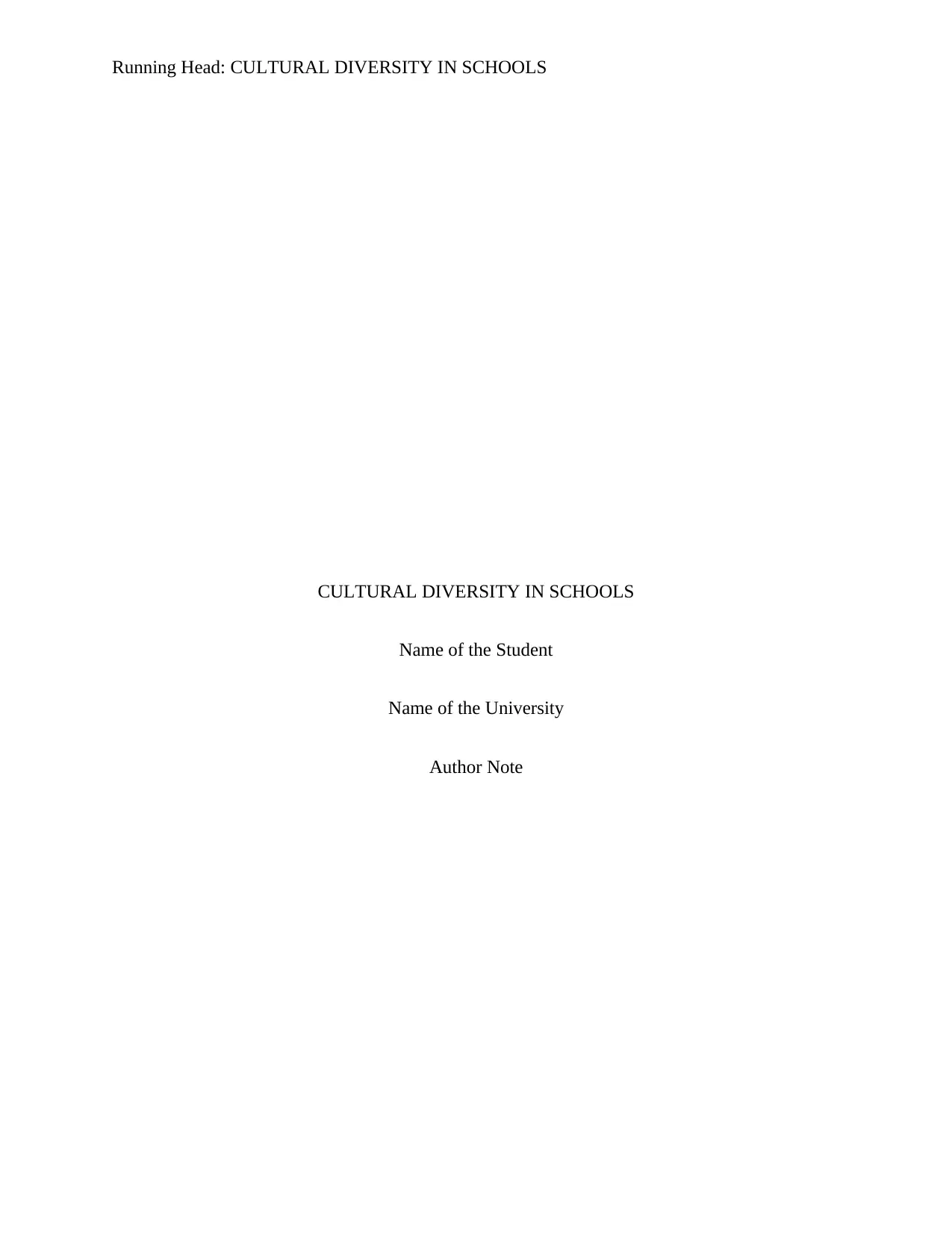
Running Head: CULTURAL DIVERSITY IN SCHOOLS
CULTURAL DIVERSITY IN SCHOOLS
Name of the Student
Name of the University
Author Note
CULTURAL DIVERSITY IN SCHOOLS
Name of the Student
Name of the University
Author Note
Secure Best Marks with AI Grader
Need help grading? Try our AI Grader for instant feedback on your assignments.
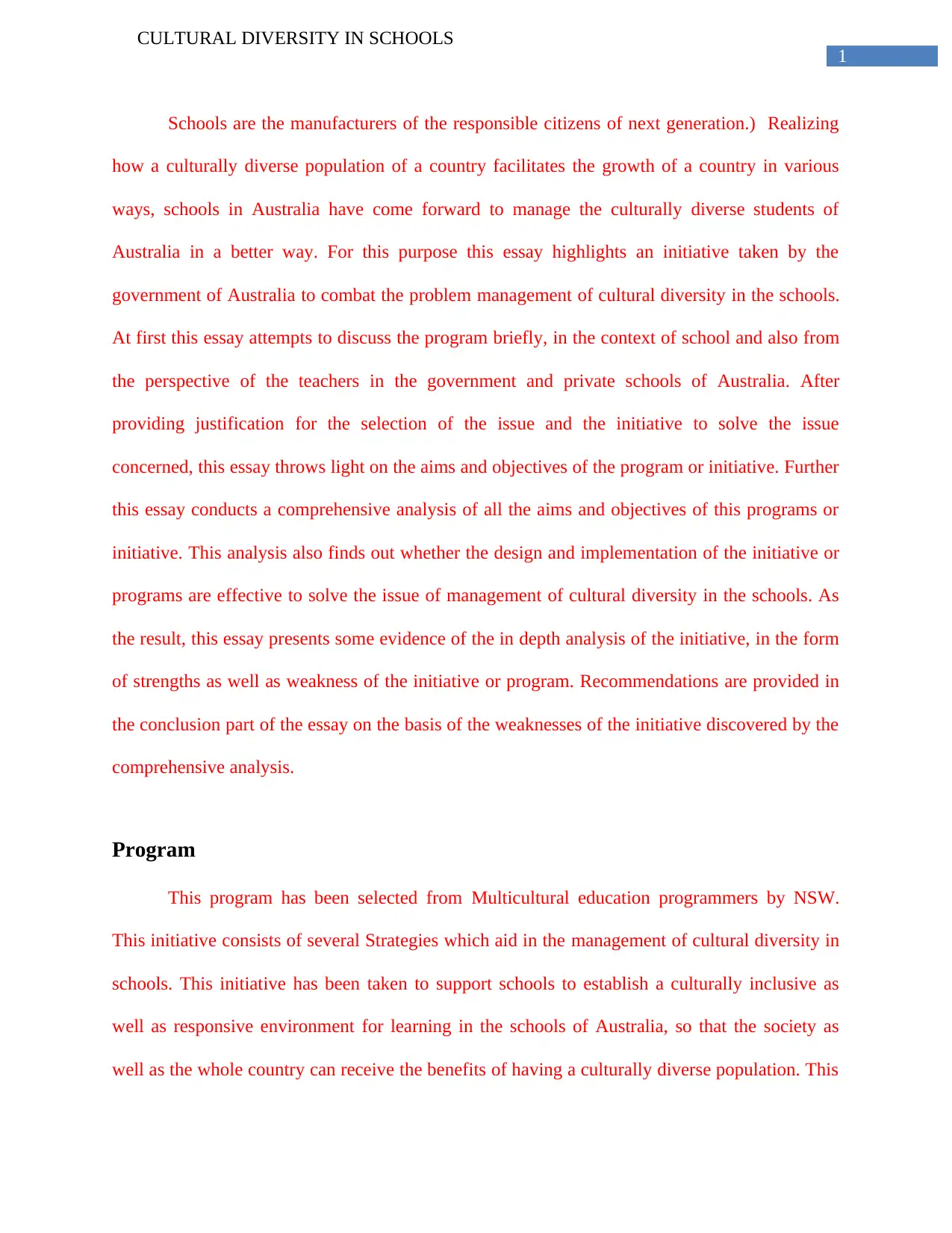
1
CULTURAL DIVERSITY IN SCHOOLS
Schools are the manufacturers of the responsible citizens of next generation.) Realizing
how a culturally diverse population of a country facilitates the growth of a country in various
ways, schools in Australia have come forward to manage the culturally diverse students of
Australia in a better way. For this purpose this essay highlights an initiative taken by the
government of Australia to combat the problem management of cultural diversity in the schools.
At first this essay attempts to discuss the program briefly, in the context of school and also from
the perspective of the teachers in the government and private schools of Australia. After
providing justification for the selection of the issue and the initiative to solve the issue
concerned, this essay throws light on the aims and objectives of the program or initiative. Further
this essay conducts a comprehensive analysis of all the aims and objectives of this programs or
initiative. This analysis also finds out whether the design and implementation of the initiative or
programs are effective to solve the issue of management of cultural diversity in the schools. As
the result, this essay presents some evidence of the in depth analysis of the initiative, in the form
of strengths as well as weakness of the initiative or program. Recommendations are provided in
the conclusion part of the essay on the basis of the weaknesses of the initiative discovered by the
comprehensive analysis.
Program
This program has been selected from Multicultural education programmers by NSW.
This initiative consists of several Strategies which aid in the management of cultural diversity in
schools. This initiative has been taken to support schools to establish a culturally inclusive as
well as responsive environment for learning in the schools of Australia, so that the society as
well as the whole country can receive the benefits of having a culturally diverse population. This
CULTURAL DIVERSITY IN SCHOOLS
Schools are the manufacturers of the responsible citizens of next generation.) Realizing
how a culturally diverse population of a country facilitates the growth of a country in various
ways, schools in Australia have come forward to manage the culturally diverse students of
Australia in a better way. For this purpose this essay highlights an initiative taken by the
government of Australia to combat the problem management of cultural diversity in the schools.
At first this essay attempts to discuss the program briefly, in the context of school and also from
the perspective of the teachers in the government and private schools of Australia. After
providing justification for the selection of the issue and the initiative to solve the issue
concerned, this essay throws light on the aims and objectives of the program or initiative. Further
this essay conducts a comprehensive analysis of all the aims and objectives of this programs or
initiative. This analysis also finds out whether the design and implementation of the initiative or
programs are effective to solve the issue of management of cultural diversity in the schools. As
the result, this essay presents some evidence of the in depth analysis of the initiative, in the form
of strengths as well as weakness of the initiative or program. Recommendations are provided in
the conclusion part of the essay on the basis of the weaknesses of the initiative discovered by the
comprehensive analysis.
Program
This program has been selected from Multicultural education programmers by NSW.
This initiative consists of several Strategies which aid in the management of cultural diversity in
schools. This initiative has been taken to support schools to establish a culturally inclusive as
well as responsive environment for learning in the schools of Australia, so that the society as
well as the whole country can receive the benefits of having a culturally diverse population. This
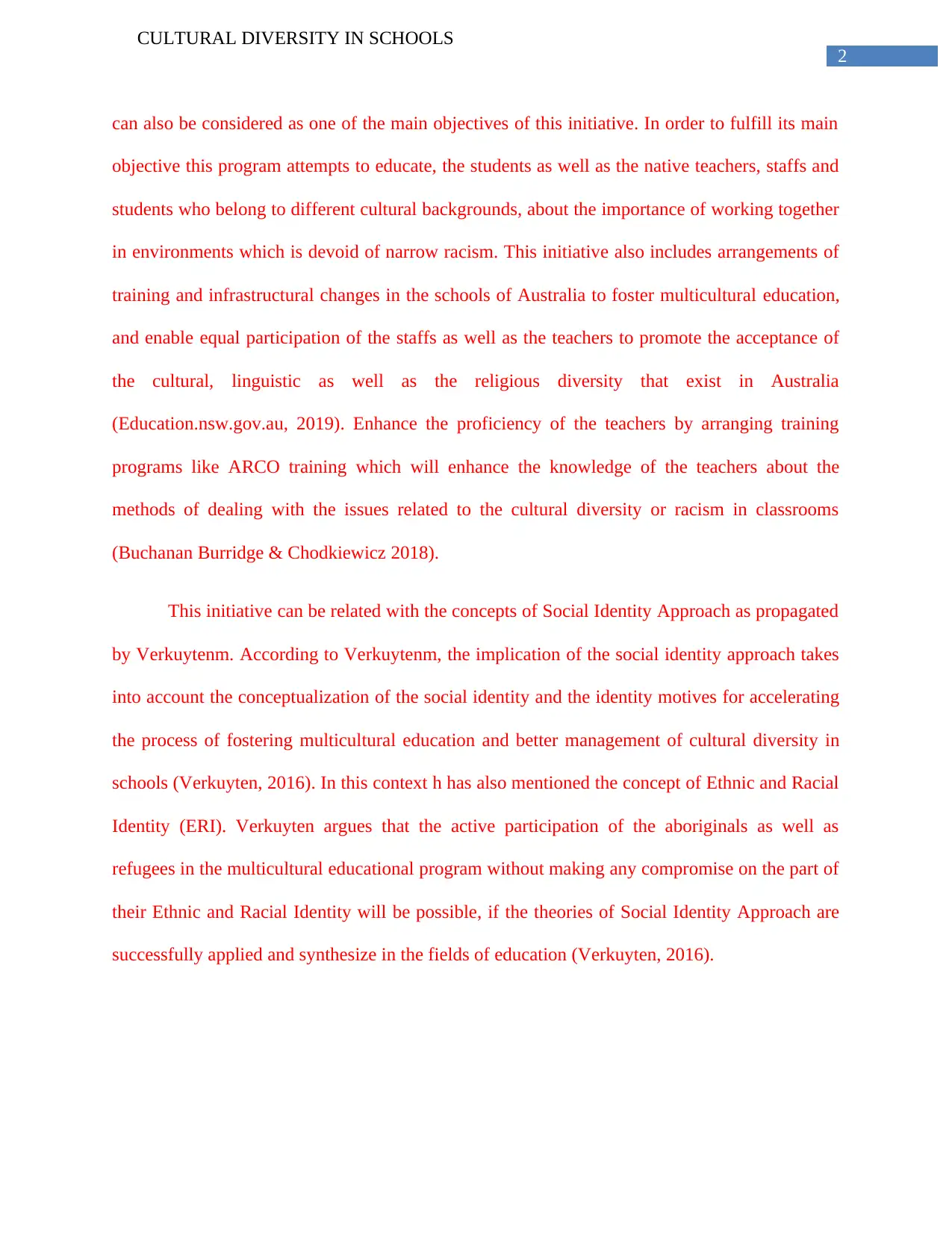
2
CULTURAL DIVERSITY IN SCHOOLS
can also be considered as one of the main objectives of this initiative. In order to fulfill its main
objective this program attempts to educate, the students as well as the native teachers, staffs and
students who belong to different cultural backgrounds, about the importance of working together
in environments which is devoid of narrow racism. This initiative also includes arrangements of
training and infrastructural changes in the schools of Australia to foster multicultural education,
and enable equal participation of the staffs as well as the teachers to promote the acceptance of
the cultural, linguistic as well as the religious diversity that exist in Australia
(Education.nsw.gov.au, 2019). Enhance the proficiency of the teachers by arranging training
programs like ARCO training which will enhance the knowledge of the teachers about the
methods of dealing with the issues related to the cultural diversity or racism in classrooms
(Buchanan Burridge & Chodkiewicz 2018).
This initiative can be related with the concepts of Social Identity Approach as propagated
by Verkuytenm. According to Verkuytenm, the implication of the social identity approach takes
into account the conceptualization of the social identity and the identity motives for accelerating
the process of fostering multicultural education and better management of cultural diversity in
schools (Verkuyten, 2016). In this context h has also mentioned the concept of Ethnic and Racial
Identity (ERI). Verkuyten argues that the active participation of the aboriginals as well as
refugees in the multicultural educational program without making any compromise on the part of
their Ethnic and Racial Identity will be possible, if the theories of Social Identity Approach are
successfully applied and synthesize in the fields of education (Verkuyten, 2016).
CULTURAL DIVERSITY IN SCHOOLS
can also be considered as one of the main objectives of this initiative. In order to fulfill its main
objective this program attempts to educate, the students as well as the native teachers, staffs and
students who belong to different cultural backgrounds, about the importance of working together
in environments which is devoid of narrow racism. This initiative also includes arrangements of
training and infrastructural changes in the schools of Australia to foster multicultural education,
and enable equal participation of the staffs as well as the teachers to promote the acceptance of
the cultural, linguistic as well as the religious diversity that exist in Australia
(Education.nsw.gov.au, 2019). Enhance the proficiency of the teachers by arranging training
programs like ARCO training which will enhance the knowledge of the teachers about the
methods of dealing with the issues related to the cultural diversity or racism in classrooms
(Buchanan Burridge & Chodkiewicz 2018).
This initiative can be related with the concepts of Social Identity Approach as propagated
by Verkuytenm. According to Verkuytenm, the implication of the social identity approach takes
into account the conceptualization of the social identity and the identity motives for accelerating
the process of fostering multicultural education and better management of cultural diversity in
schools (Verkuyten, 2016). In this context h has also mentioned the concept of Ethnic and Racial
Identity (ERI). Verkuyten argues that the active participation of the aboriginals as well as
refugees in the multicultural educational program without making any compromise on the part of
their Ethnic and Racial Identity will be possible, if the theories of Social Identity Approach are
successfully applied and synthesize in the fields of education (Verkuyten, 2016).
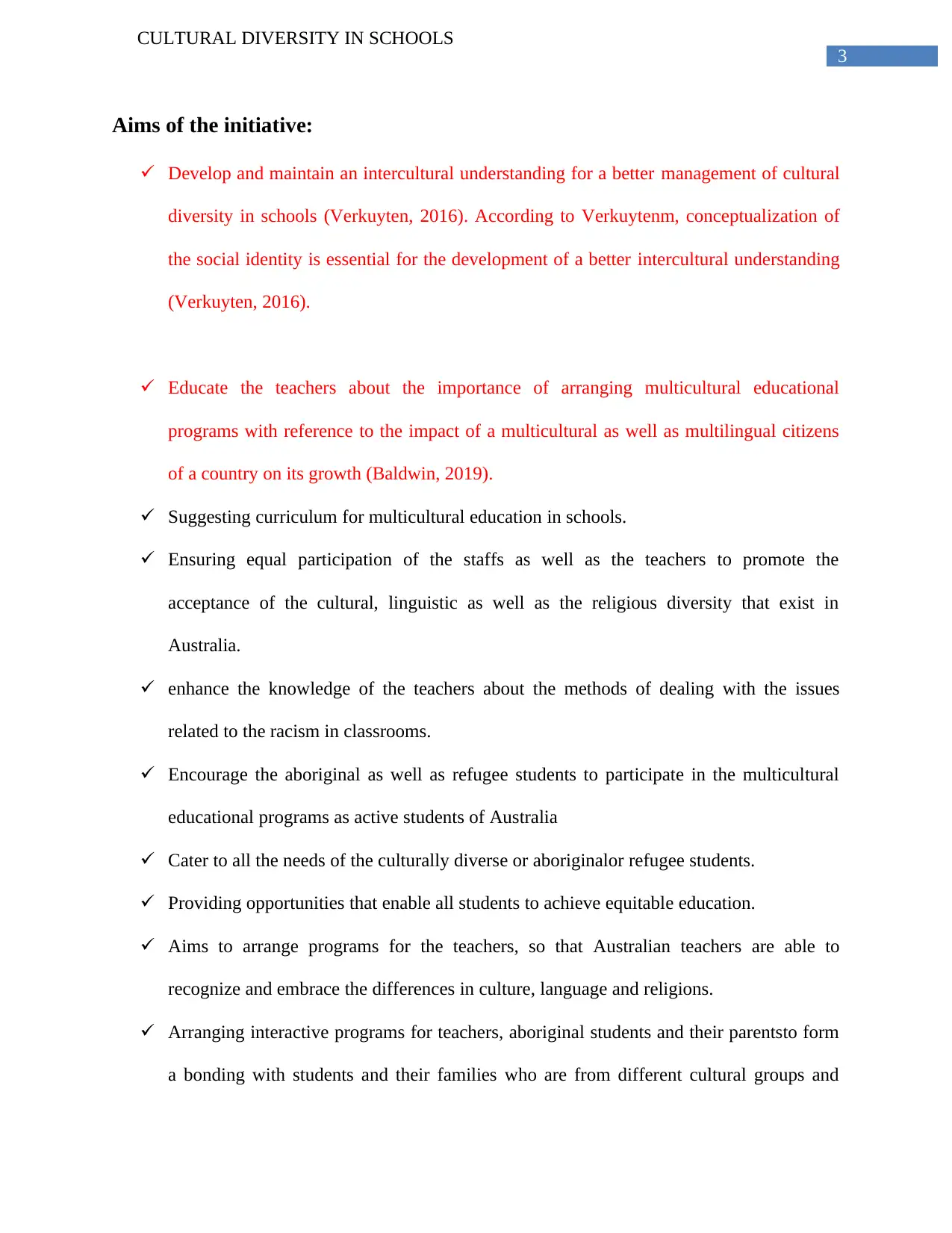
3
CULTURAL DIVERSITY IN SCHOOLS
Aims of the initiative:
Develop and maintain an intercultural understanding for a better management of cultural
diversity in schools (Verkuyten, 2016). According to Verkuytenm, conceptualization of
the social identity is essential for the development of a better intercultural understanding
(Verkuyten, 2016).
Educate the teachers about the importance of arranging multicultural educational
programs with reference to the impact of a multicultural as well as multilingual citizens
of a country on its growth (Baldwin, 2019).
Suggesting curriculum for multicultural education in schools.
Ensuring equal participation of the staffs as well as the teachers to promote the
acceptance of the cultural, linguistic as well as the religious diversity that exist in
Australia.
enhance the knowledge of the teachers about the methods of dealing with the issues
related to the racism in classrooms.
Encourage the aboriginal as well as refugee students to participate in the multicultural
educational programs as active students of Australia
Cater to all the needs of the culturally diverse or aboriginalor refugee students.
Providing opportunities that enable all students to achieve equitable education.
Aims to arrange programs for the teachers, so that Australian teachers are able to
recognize and embrace the differences in culture, language and religions.
Arranging interactive programs for teachers, aboriginal students and their parentsto form
a bonding with students and their families who are from different cultural groups and
CULTURAL DIVERSITY IN SCHOOLS
Aims of the initiative:
Develop and maintain an intercultural understanding for a better management of cultural
diversity in schools (Verkuyten, 2016). According to Verkuytenm, conceptualization of
the social identity is essential for the development of a better intercultural understanding
(Verkuyten, 2016).
Educate the teachers about the importance of arranging multicultural educational
programs with reference to the impact of a multicultural as well as multilingual citizens
of a country on its growth (Baldwin, 2019).
Suggesting curriculum for multicultural education in schools.
Ensuring equal participation of the staffs as well as the teachers to promote the
acceptance of the cultural, linguistic as well as the religious diversity that exist in
Australia.
enhance the knowledge of the teachers about the methods of dealing with the issues
related to the racism in classrooms.
Encourage the aboriginal as well as refugee students to participate in the multicultural
educational programs as active students of Australia
Cater to all the needs of the culturally diverse or aboriginalor refugee students.
Providing opportunities that enable all students to achieve equitable education.
Aims to arrange programs for the teachers, so that Australian teachers are able to
recognize and embrace the differences in culture, language and religions.
Arranging interactive programs for teachers, aboriginal students and their parentsto form
a bonding with students and their families who are from different cultural groups and
Secure Best Marks with AI Grader
Need help grading? Try our AI Grader for instant feedback on your assignments.
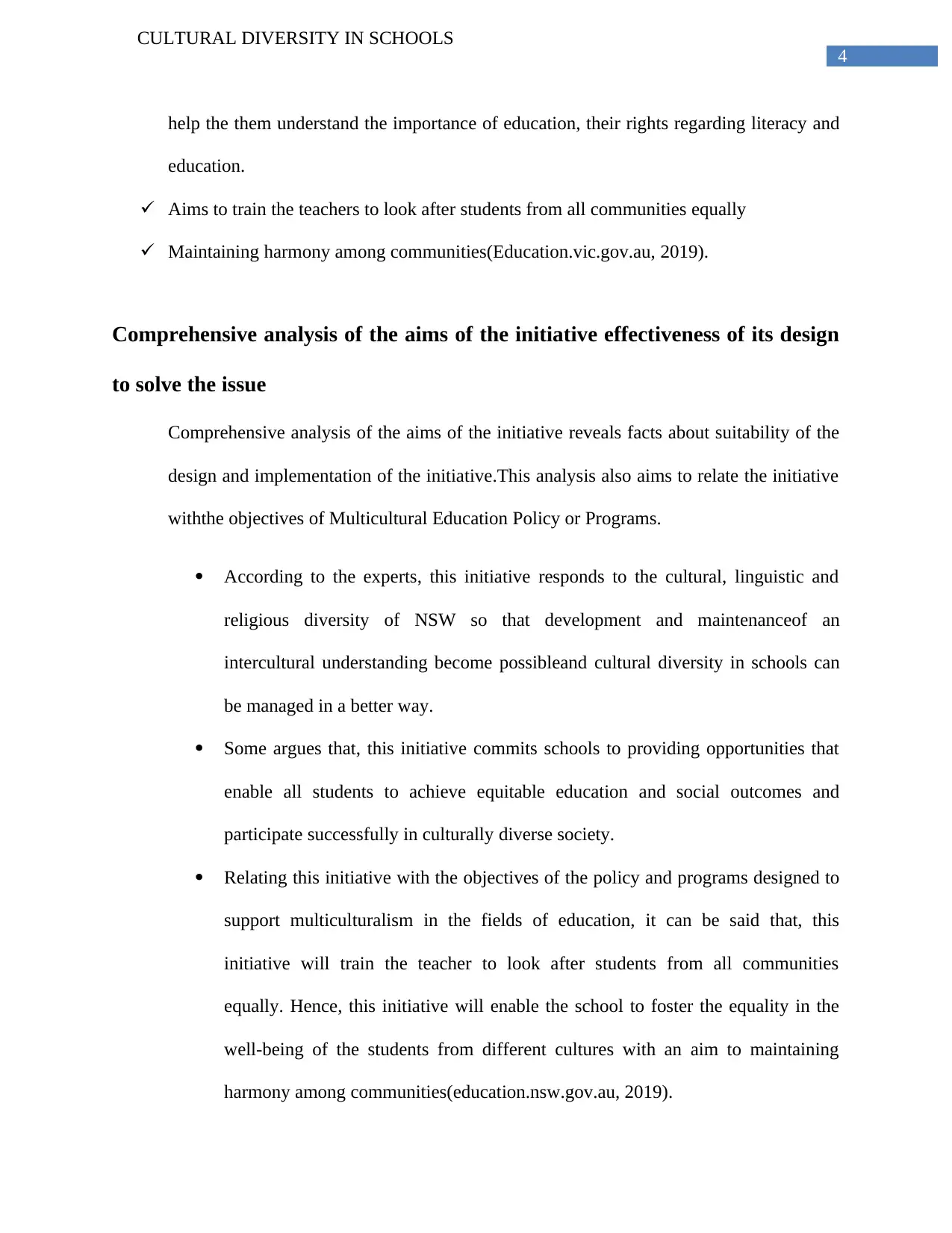
4
CULTURAL DIVERSITY IN SCHOOLS
help the them understand the importance of education, their rights regarding literacy and
education.
Aims to train the teachers to look after students from all communities equally
Maintaining harmony among communities(Education.vic.gov.au, 2019).
Comprehensive analysis of the aims of the initiative effectiveness of its design
to solve the issue
Comprehensive analysis of the aims of the initiative reveals facts about suitability of the
design and implementation of the initiative.This analysis also aims to relate the initiative
withthe objectives of Multicultural Education Policy or Programs.
According to the experts, this initiative responds to the cultural, linguistic and
religious diversity of NSW so that development and maintenanceof an
intercultural understanding become possibleand cultural diversity in schools can
be managed in a better way.
Some argues that, this initiative commits schools to providing opportunities that
enable all students to achieve equitable education and social outcomes and
participate successfully in culturally diverse society.
Relating this initiative with the objectives of the policy and programs designed to
support multiculturalism in the fields of education, it can be said that, this
initiative will train the teacher to look after students from all communities
equally. Hence, this initiative will enable the school to foster the equality in the
well-being of the students from different cultures with an aim to maintaining
harmony among communities(education.nsw.gov.au, 2019).
CULTURAL DIVERSITY IN SCHOOLS
help the them understand the importance of education, their rights regarding literacy and
education.
Aims to train the teachers to look after students from all communities equally
Maintaining harmony among communities(Education.vic.gov.au, 2019).
Comprehensive analysis of the aims of the initiative effectiveness of its design
to solve the issue
Comprehensive analysis of the aims of the initiative reveals facts about suitability of the
design and implementation of the initiative.This analysis also aims to relate the initiative
withthe objectives of Multicultural Education Policy or Programs.
According to the experts, this initiative responds to the cultural, linguistic and
religious diversity of NSW so that development and maintenanceof an
intercultural understanding become possibleand cultural diversity in schools can
be managed in a better way.
Some argues that, this initiative commits schools to providing opportunities that
enable all students to achieve equitable education and social outcomes and
participate successfully in culturally diverse society.
Relating this initiative with the objectives of the policy and programs designed to
support multiculturalism in the fields of education, it can be said that, this
initiative will train the teacher to look after students from all communities
equally. Hence, this initiative will enable the school to foster the equality in the
well-being of the students from different cultures with an aim to maintaining
harmony among communities(education.nsw.gov.au, 2019).
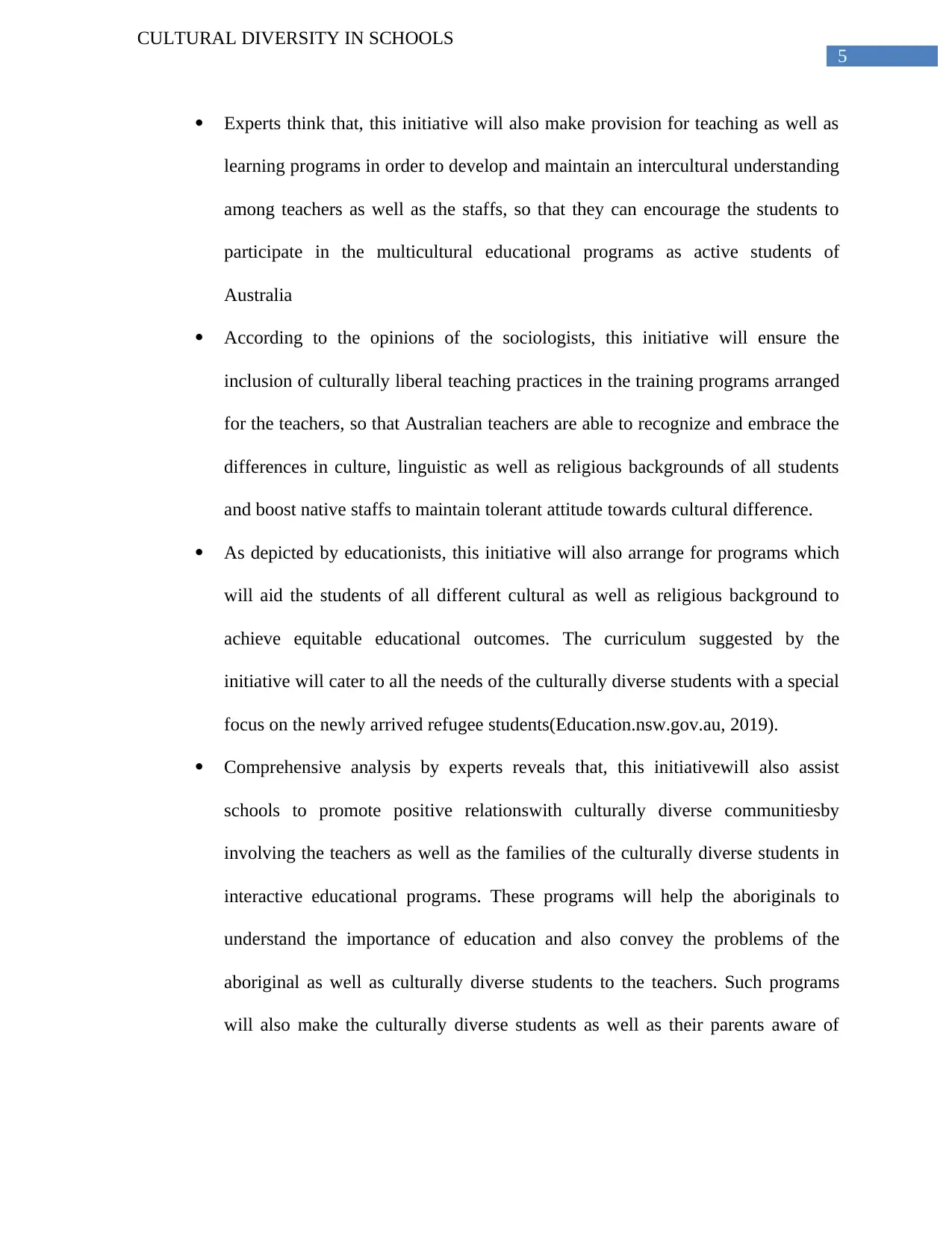
5
CULTURAL DIVERSITY IN SCHOOLS
Experts think that, this initiative will also make provision for teaching as well as
learning programs in order to develop and maintain an intercultural understanding
among teachers as well as the staffs, so that they can encourage the students to
participate in the multicultural educational programs as active students of
Australia
According to the opinions of the sociologists, this initiative will ensure the
inclusion of culturally liberal teaching practices in the training programs arranged
for the teachers, so that Australian teachers are able to recognize and embrace the
differences in culture, linguistic as well as religious backgrounds of all students
and boost native staffs to maintain tolerant attitude towards cultural difference.
As depicted by educationists, this initiative will also arrange for programs which
will aid the students of all different cultural as well as religious background to
achieve equitable educational outcomes. The curriculum suggested by the
initiative will cater to all the needs of the culturally diverse students with a special
focus on the newly arrived refugee students(Education.nsw.gov.au, 2019).
Comprehensive analysis by experts reveals that, this initiativewill also assist
schools to promote positive relationswith culturally diverse communitiesby
involving the teachers as well as the families of the culturally diverse students in
interactive educational programs. These programs will help the aboriginals to
understand the importance of education and also convey the problems of the
aboriginal as well as culturally diverse students to the teachers. Such programs
will also make the culturally diverse students as well as their parents aware of
CULTURAL DIVERSITY IN SCHOOLS
Experts think that, this initiative will also make provision for teaching as well as
learning programs in order to develop and maintain an intercultural understanding
among teachers as well as the staffs, so that they can encourage the students to
participate in the multicultural educational programs as active students of
Australia
According to the opinions of the sociologists, this initiative will ensure the
inclusion of culturally liberal teaching practices in the training programs arranged
for the teachers, so that Australian teachers are able to recognize and embrace the
differences in culture, linguistic as well as religious backgrounds of all students
and boost native staffs to maintain tolerant attitude towards cultural difference.
As depicted by educationists, this initiative will also arrange for programs which
will aid the students of all different cultural as well as religious background to
achieve equitable educational outcomes. The curriculum suggested by the
initiative will cater to all the needs of the culturally diverse students with a special
focus on the newly arrived refugee students(Education.nsw.gov.au, 2019).
Comprehensive analysis by experts reveals that, this initiativewill also assist
schools to promote positive relationswith culturally diverse communitiesby
involving the teachers as well as the families of the culturally diverse students in
interactive educational programs. These programs will help the aboriginals to
understand the importance of education and also convey the problems of the
aboriginal as well as culturally diverse students to the teachers. Such programs
will also make the culturally diverse students as well as their parents aware of
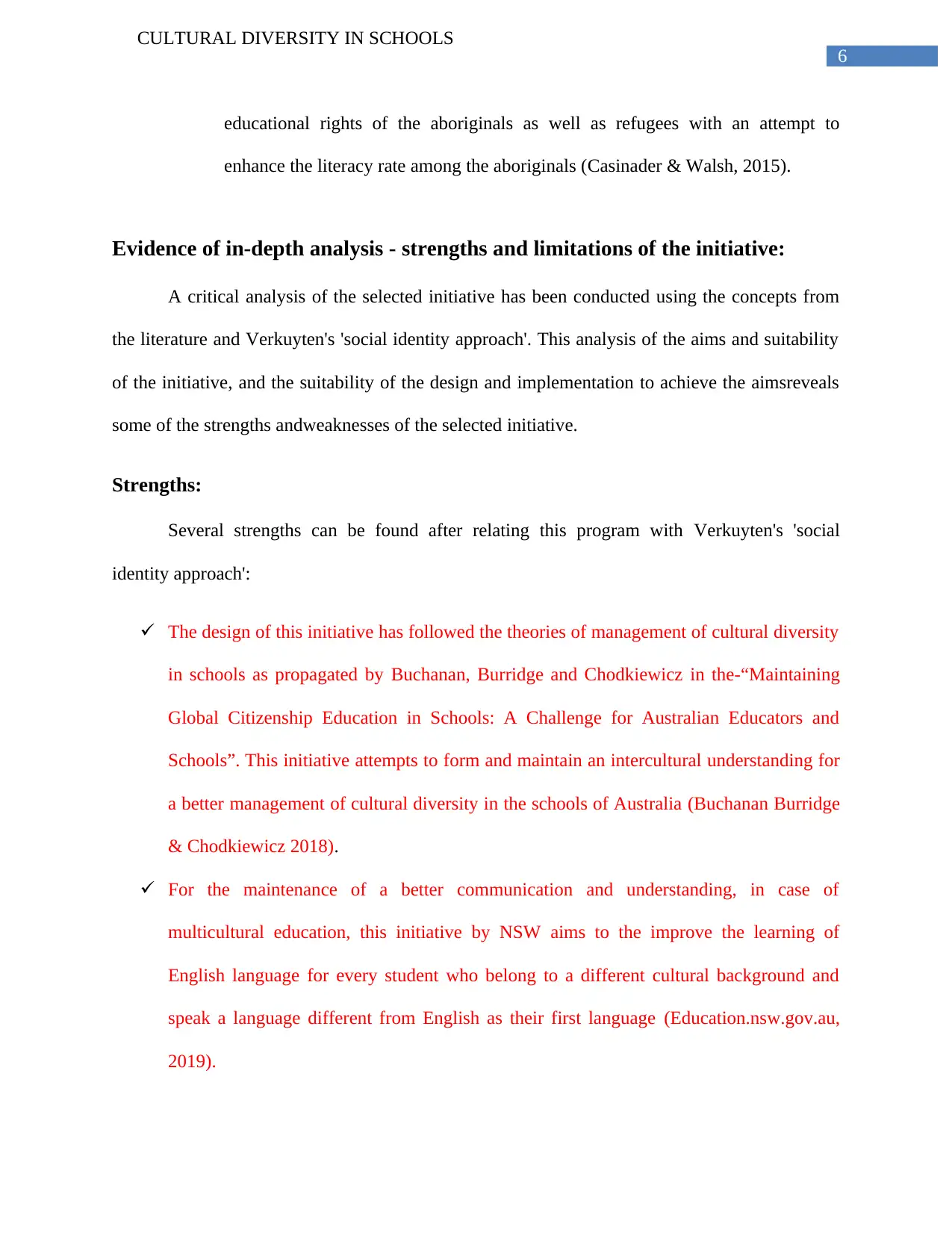
6
CULTURAL DIVERSITY IN SCHOOLS
educational rights of the aboriginals as well as refugees with an attempt to
enhance the literacy rate among the aboriginals (Casinader & Walsh, 2015).
Evidence of in-depth analysis - strengths and limitations of the initiative:
A critical analysis of the selected initiative has been conducted using the concepts from
the literature and Verkuyten's 'social identity approach'. This analysis of the aims and suitability
of the initiative, and the suitability of the design and implementation to achieve the aimsreveals
some of the strengths andweaknesses of the selected initiative.
Strengths:
Several strengths can be found after relating this program with Verkuyten's 'social
identity approach':
The design of this initiative has followed the theories of management of cultural diversity
in schools as propagated by Buchanan, Burridge and Chodkiewicz in the-“Maintaining
Global Citizenship Education in Schools: A Challenge for Australian Educators and
Schools”. This initiative attempts to form and maintain an intercultural understanding for
a better management of cultural diversity in the schools of Australia (Buchanan Burridge
& Chodkiewicz 2018).
For the maintenance of a better communication and understanding, in case of
multicultural education, this initiative by NSW aims to the improve the learning of
English language for every student who belong to a different cultural background and
speak a language different from English as their first language (Education.nsw.gov.au,
2019).
CULTURAL DIVERSITY IN SCHOOLS
educational rights of the aboriginals as well as refugees with an attempt to
enhance the literacy rate among the aboriginals (Casinader & Walsh, 2015).
Evidence of in-depth analysis - strengths and limitations of the initiative:
A critical analysis of the selected initiative has been conducted using the concepts from
the literature and Verkuyten's 'social identity approach'. This analysis of the aims and suitability
of the initiative, and the suitability of the design and implementation to achieve the aimsreveals
some of the strengths andweaknesses of the selected initiative.
Strengths:
Several strengths can be found after relating this program with Verkuyten's 'social
identity approach':
The design of this initiative has followed the theories of management of cultural diversity
in schools as propagated by Buchanan, Burridge and Chodkiewicz in the-“Maintaining
Global Citizenship Education in Schools: A Challenge for Australian Educators and
Schools”. This initiative attempts to form and maintain an intercultural understanding for
a better management of cultural diversity in the schools of Australia (Buchanan Burridge
& Chodkiewicz 2018).
For the maintenance of a better communication and understanding, in case of
multicultural education, this initiative by NSW aims to the improve the learning of
English language for every student who belong to a different cultural background and
speak a language different from English as their first language (Education.nsw.gov.au,
2019).
Paraphrase This Document
Need a fresh take? Get an instant paraphrase of this document with our AI Paraphraser
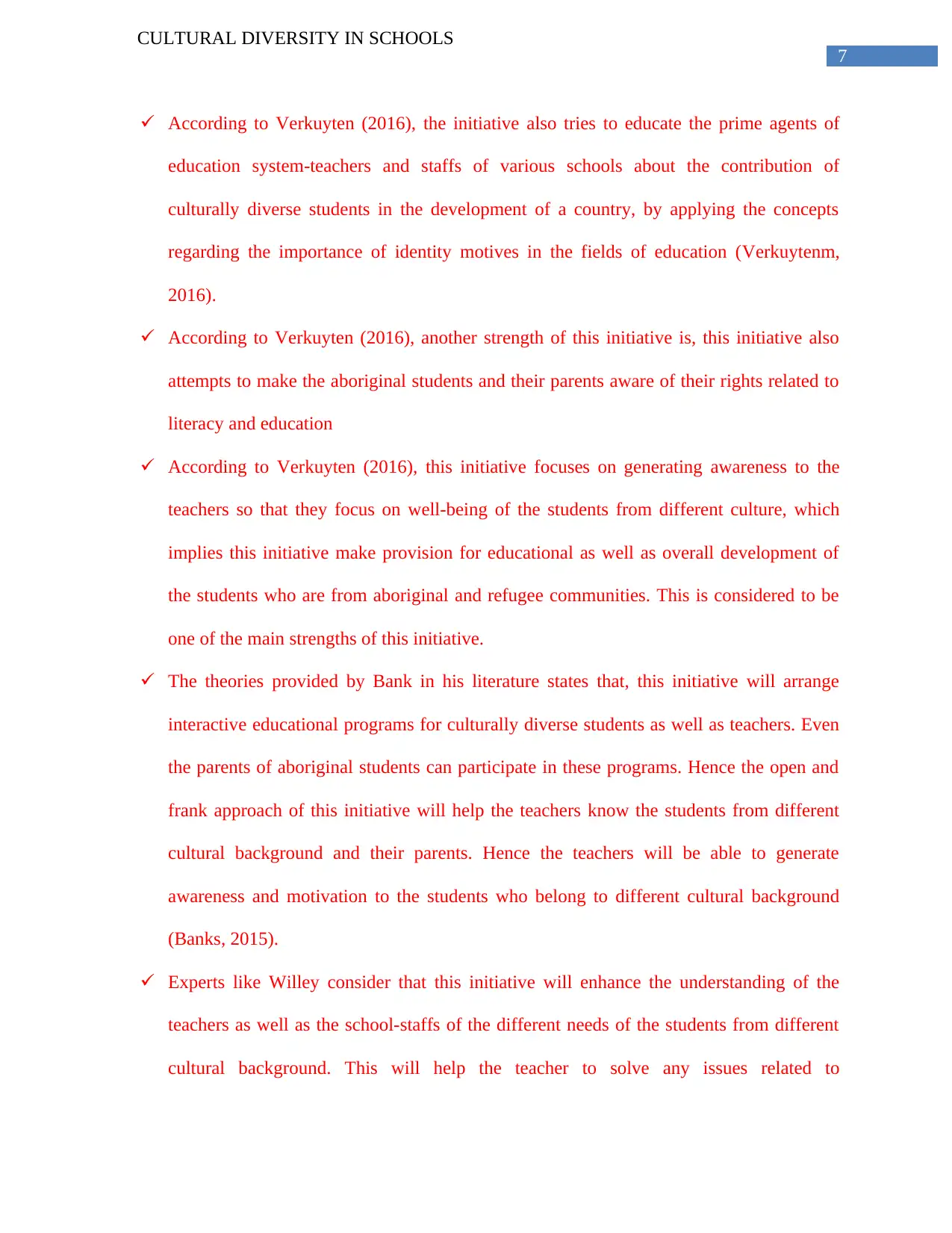
7
CULTURAL DIVERSITY IN SCHOOLS
According to Verkuyten (2016), the initiative also tries to educate the prime agents of
education system-teachers and staffs of various schools about the contribution of
culturally diverse students in the development of a country, by applying the concepts
regarding the importance of identity motives in the fields of education (Verkuytenm,
2016).
According to Verkuyten (2016), another strength of this initiative is, this initiative also
attempts to make the aboriginal students and their parents aware of their rights related to
literacy and education
According to Verkuyten (2016), this initiative focuses on generating awareness to the
teachers so that they focus on well-being of the students from different culture, which
implies this initiative make provision for educational as well as overall development of
the students who are from aboriginal and refugee communities. This is considered to be
one of the main strengths of this initiative.
The theories provided by Bank in his literature states that, this initiative will arrange
interactive educational programs for culturally diverse students as well as teachers. Even
the parents of aboriginal students can participate in these programs. Hence the open and
frank approach of this initiative will help the teachers know the students from different
cultural background and their parents. Hence the teachers will be able to generate
awareness and motivation to the students who belong to different cultural background
(Banks, 2015).
Experts like Willey consider that this initiative will enhance the understanding of the
teachers as well as the school-staffs of the different needs of the students from different
cultural background. This will help the teacher to solve any issues related to
CULTURAL DIVERSITY IN SCHOOLS
According to Verkuyten (2016), the initiative also tries to educate the prime agents of
education system-teachers and staffs of various schools about the contribution of
culturally diverse students in the development of a country, by applying the concepts
regarding the importance of identity motives in the fields of education (Verkuytenm,
2016).
According to Verkuyten (2016), another strength of this initiative is, this initiative also
attempts to make the aboriginal students and their parents aware of their rights related to
literacy and education
According to Verkuyten (2016), this initiative focuses on generating awareness to the
teachers so that they focus on well-being of the students from different culture, which
implies this initiative make provision for educational as well as overall development of
the students who are from aboriginal and refugee communities. This is considered to be
one of the main strengths of this initiative.
The theories provided by Bank in his literature states that, this initiative will arrange
interactive educational programs for culturally diverse students as well as teachers. Even
the parents of aboriginal students can participate in these programs. Hence the open and
frank approach of this initiative will help the teachers know the students from different
cultural background and their parents. Hence the teachers will be able to generate
awareness and motivation to the students who belong to different cultural background
(Banks, 2015).
Experts like Willey consider that this initiative will enhance the understanding of the
teachers as well as the school-staffs of the different needs of the students from different
cultural background. This will help the teacher to solve any issues related to
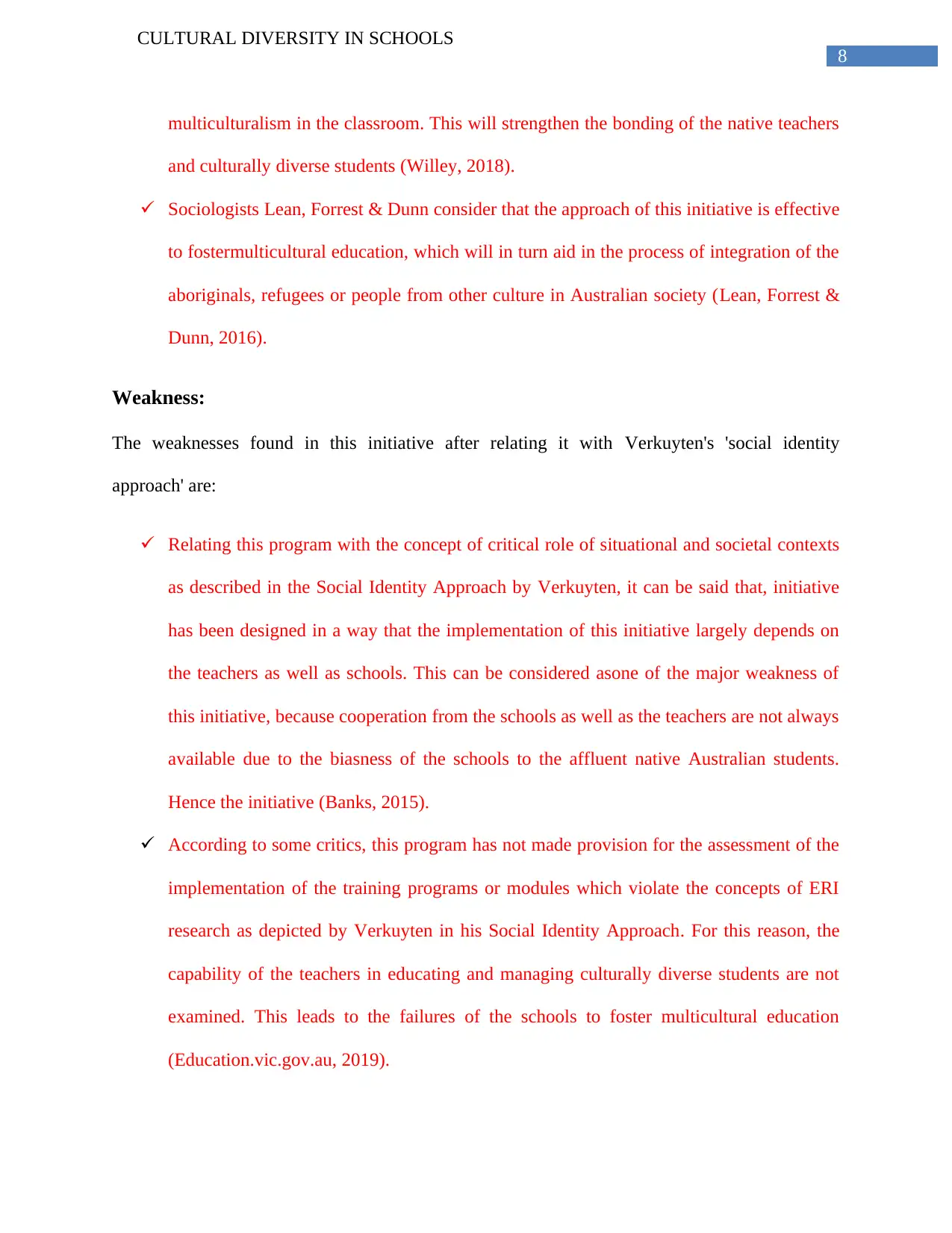
8
CULTURAL DIVERSITY IN SCHOOLS
multiculturalism in the classroom. This will strengthen the bonding of the native teachers
and culturally diverse students (Willey, 2018).
Sociologists Lean, Forrest & Dunn consider that the approach of this initiative is effective
to fostermulticultural education, which will in turn aid in the process of integration of the
aboriginals, refugees or people from other culture in Australian society (Lean, Forrest &
Dunn, 2016).
Weakness:
The weaknesses found in this initiative after relating it with Verkuyten's 'social identity
approach' are:
Relating this program with the concept of critical role of situational and societal contexts
as described in the Social Identity Approach by Verkuyten, it can be said that, initiative
has been designed in a way that the implementation of this initiative largely depends on
the teachers as well as schools. This can be considered asone of the major weakness of
this initiative, because cooperation from the schools as well as the teachers are not always
available due to the biasness of the schools to the affluent native Australian students.
Hence the initiative (Banks, 2015).
According to some critics, this program has not made provision for the assessment of the
implementation of the training programs or modules which violate the concepts of ERI
research as depicted by Verkuyten in his Social Identity Approach. For this reason, the
capability of the teachers in educating and managing culturally diverse students are not
examined. This leads to the failures of the schools to foster multicultural education
(Education.vic.gov.au, 2019).
CULTURAL DIVERSITY IN SCHOOLS
multiculturalism in the classroom. This will strengthen the bonding of the native teachers
and culturally diverse students (Willey, 2018).
Sociologists Lean, Forrest & Dunn consider that the approach of this initiative is effective
to fostermulticultural education, which will in turn aid in the process of integration of the
aboriginals, refugees or people from other culture in Australian society (Lean, Forrest &
Dunn, 2016).
Weakness:
The weaknesses found in this initiative after relating it with Verkuyten's 'social identity
approach' are:
Relating this program with the concept of critical role of situational and societal contexts
as described in the Social Identity Approach by Verkuyten, it can be said that, initiative
has been designed in a way that the implementation of this initiative largely depends on
the teachers as well as schools. This can be considered asone of the major weakness of
this initiative, because cooperation from the schools as well as the teachers are not always
available due to the biasness of the schools to the affluent native Australian students.
Hence the initiative (Banks, 2015).
According to some critics, this program has not made provision for the assessment of the
implementation of the training programs or modules which violate the concepts of ERI
research as depicted by Verkuyten in his Social Identity Approach. For this reason, the
capability of the teachers in educating and managing culturally diverse students are not
examined. This leads to the failures of the schools to foster multicultural education
(Education.vic.gov.au, 2019).
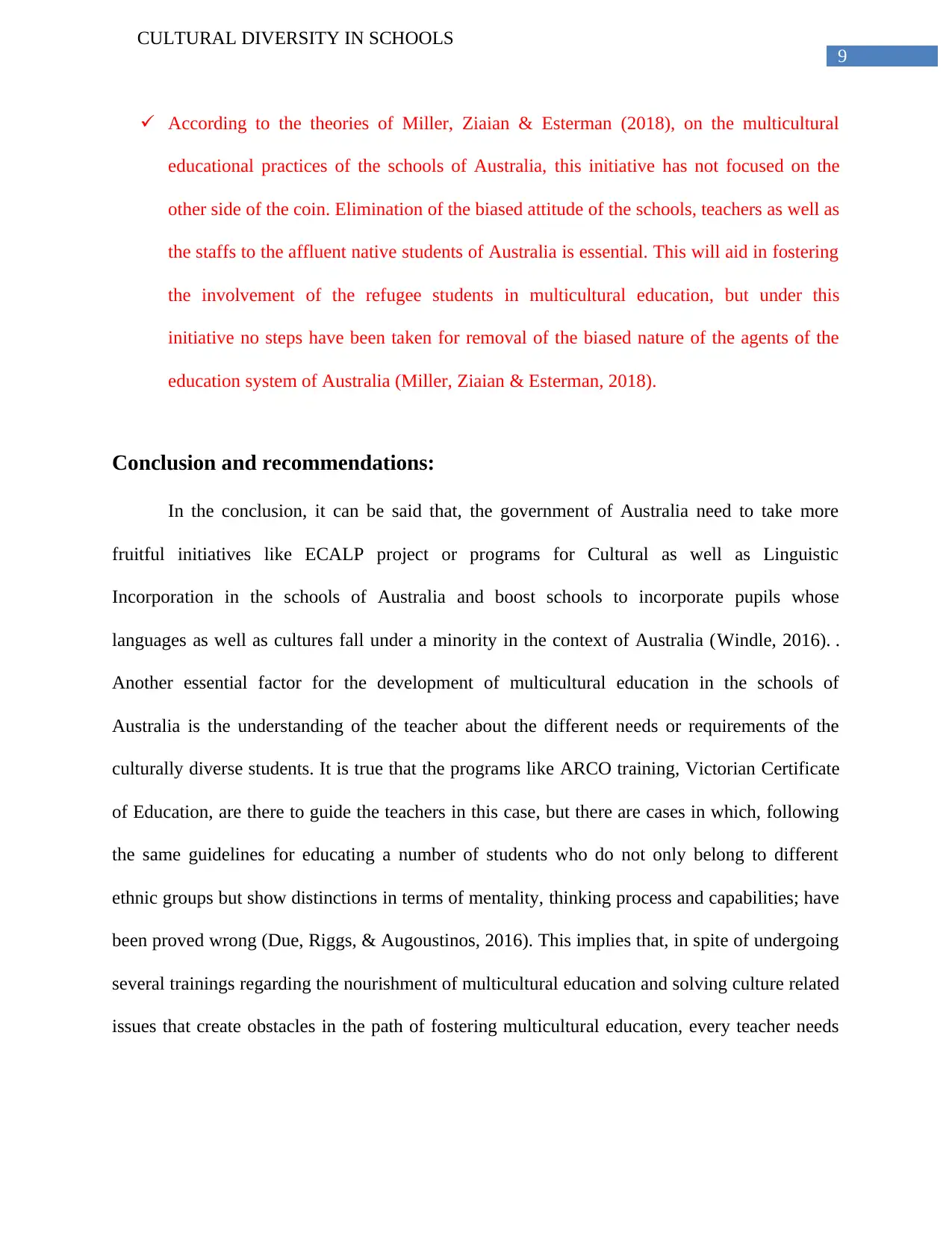
9
CULTURAL DIVERSITY IN SCHOOLS
According to the theories of Miller, Ziaian & Esterman (2018), on the multicultural
educational practices of the schools of Australia, this initiative has not focused on the
other side of the coin. Elimination of the biased attitude of the schools, teachers as well as
the staffs to the affluent native students of Australia is essential. This will aid in fostering
the involvement of the refugee students in multicultural education, but under this
initiative no steps have been taken for removal of the biased nature of the agents of the
education system of Australia (Miller, Ziaian & Esterman, 2018).
Conclusion and recommendations:
In the conclusion, it can be said that, the government of Australia need to take more
fruitful initiatives like ECALP project or programs for Cultural as well as Linguistic
Incorporation in the schools of Australia and boost schools to incorporate pupils whose
languages as well as cultures fall under a minority in the context of Australia (Windle, 2016). .
Another essential factor for the development of multicultural education in the schools of
Australia is the understanding of the teacher about the different needs or requirements of the
culturally diverse students. It is true that the programs like ARCO training, Victorian Certificate
of Education, are there to guide the teachers in this case, but there are cases in which, following
the same guidelines for educating a number of students who do not only belong to different
ethnic groups but show distinctions in terms of mentality, thinking process and capabilities; have
been proved wrong (Due, Riggs, & Augoustinos, 2016). This implies that, in spite of undergoing
several trainings regarding the nourishment of multicultural education and solving culture related
issues that create obstacles in the path of fostering multicultural education, every teacher needs
CULTURAL DIVERSITY IN SCHOOLS
According to the theories of Miller, Ziaian & Esterman (2018), on the multicultural
educational practices of the schools of Australia, this initiative has not focused on the
other side of the coin. Elimination of the biased attitude of the schools, teachers as well as
the staffs to the affluent native students of Australia is essential. This will aid in fostering
the involvement of the refugee students in multicultural education, but under this
initiative no steps have been taken for removal of the biased nature of the agents of the
education system of Australia (Miller, Ziaian & Esterman, 2018).
Conclusion and recommendations:
In the conclusion, it can be said that, the government of Australia need to take more
fruitful initiatives like ECALP project or programs for Cultural as well as Linguistic
Incorporation in the schools of Australia and boost schools to incorporate pupils whose
languages as well as cultures fall under a minority in the context of Australia (Windle, 2016). .
Another essential factor for the development of multicultural education in the schools of
Australia is the understanding of the teacher about the different needs or requirements of the
culturally diverse students. It is true that the programs like ARCO training, Victorian Certificate
of Education, are there to guide the teachers in this case, but there are cases in which, following
the same guidelines for educating a number of students who do not only belong to different
ethnic groups but show distinctions in terms of mentality, thinking process and capabilities; have
been proved wrong (Due, Riggs, & Augoustinos, 2016). This implies that, in spite of undergoing
several trainings regarding the nourishment of multicultural education and solving culture related
issues that create obstacles in the path of fostering multicultural education, every teacher needs
Secure Best Marks with AI Grader
Need help grading? Try our AI Grader for instant feedback on your assignments.
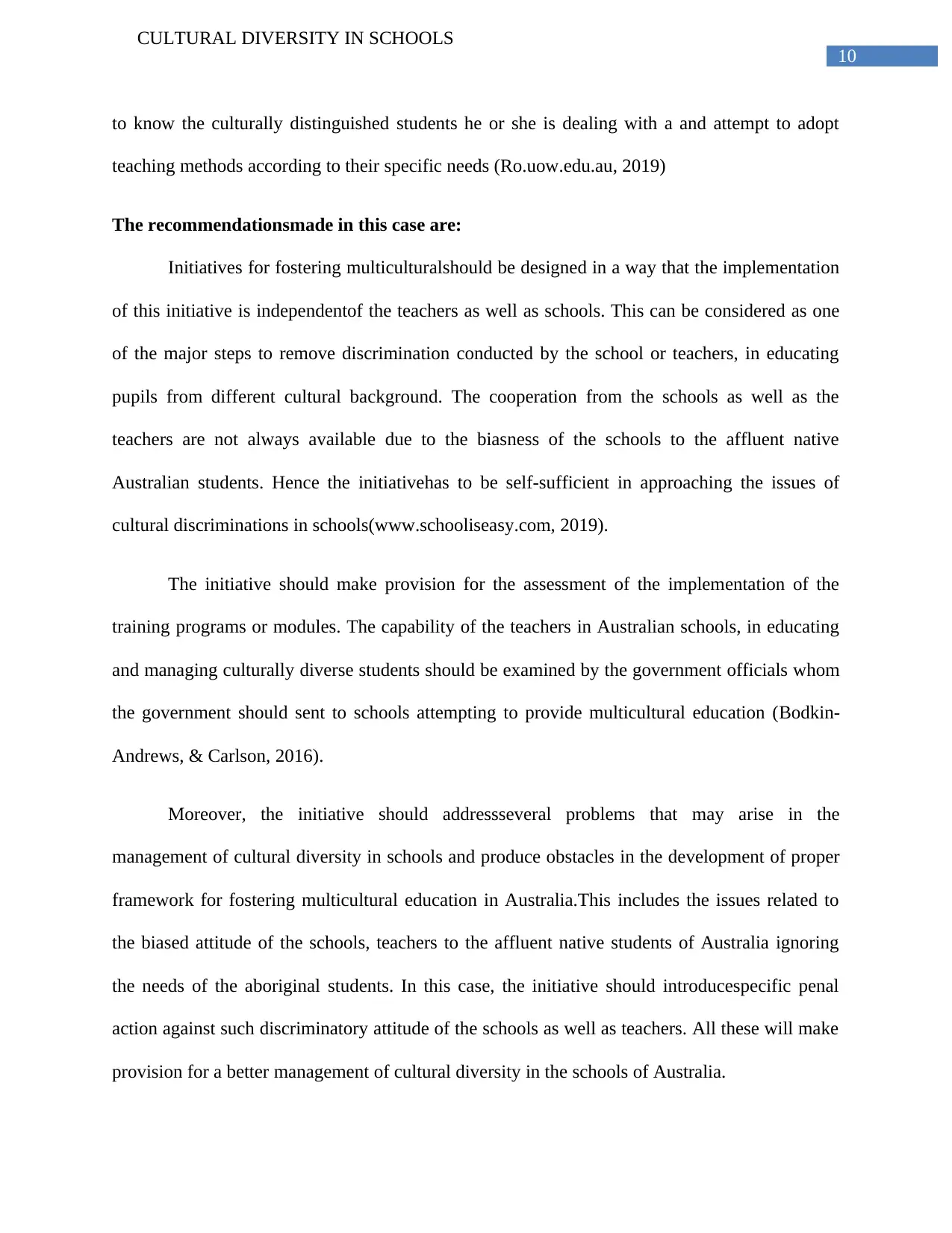
10
CULTURAL DIVERSITY IN SCHOOLS
to know the culturally distinguished students he or she is dealing with a and attempt to adopt
teaching methods according to their specific needs (Ro.uow.edu.au, 2019)
The recommendationsmade in this case are:
Initiatives for fostering multiculturalshould be designed in a way that the implementation
of this initiative is independentof the teachers as well as schools. This can be considered as one
of the major steps to remove discrimination conducted by the school or teachers, in educating
pupils from different cultural background. The cooperation from the schools as well as the
teachers are not always available due to the biasness of the schools to the affluent native
Australian students. Hence the initiativehas to be self-sufficient in approaching the issues of
cultural discriminations in schools(www.schooliseasy.com, 2019).
The initiative should make provision for the assessment of the implementation of the
training programs or modules. The capability of the teachers in Australian schools, in educating
and managing culturally diverse students should be examined by the government officials whom
the government should sent to schools attempting to provide multicultural education (Bodkin-
Andrews, & Carlson, 2016).
Moreover, the initiative should addressseveral problems that may arise in the
management of cultural diversity in schools and produce obstacles in the development of proper
framework for fostering multicultural education in Australia.This includes the issues related to
the biased attitude of the schools, teachers to the affluent native students of Australia ignoring
the needs of the aboriginal students. In this case, the initiative should introducespecific penal
action against such discriminatory attitude of the schools as well as teachers. All these will make
provision for a better management of cultural diversity in the schools of Australia.
CULTURAL DIVERSITY IN SCHOOLS
to know the culturally distinguished students he or she is dealing with a and attempt to adopt
teaching methods according to their specific needs (Ro.uow.edu.au, 2019)
The recommendationsmade in this case are:
Initiatives for fostering multiculturalshould be designed in a way that the implementation
of this initiative is independentof the teachers as well as schools. This can be considered as one
of the major steps to remove discrimination conducted by the school or teachers, in educating
pupils from different cultural background. The cooperation from the schools as well as the
teachers are not always available due to the biasness of the schools to the affluent native
Australian students. Hence the initiativehas to be self-sufficient in approaching the issues of
cultural discriminations in schools(www.schooliseasy.com, 2019).
The initiative should make provision for the assessment of the implementation of the
training programs or modules. The capability of the teachers in Australian schools, in educating
and managing culturally diverse students should be examined by the government officials whom
the government should sent to schools attempting to provide multicultural education (Bodkin-
Andrews, & Carlson, 2016).
Moreover, the initiative should addressseveral problems that may arise in the
management of cultural diversity in schools and produce obstacles in the development of proper
framework for fostering multicultural education in Australia.This includes the issues related to
the biased attitude of the schools, teachers to the affluent native students of Australia ignoring
the needs of the aboriginal students. In this case, the initiative should introducespecific penal
action against such discriminatory attitude of the schools as well as teachers. All these will make
provision for a better management of cultural diversity in the schools of Australia.
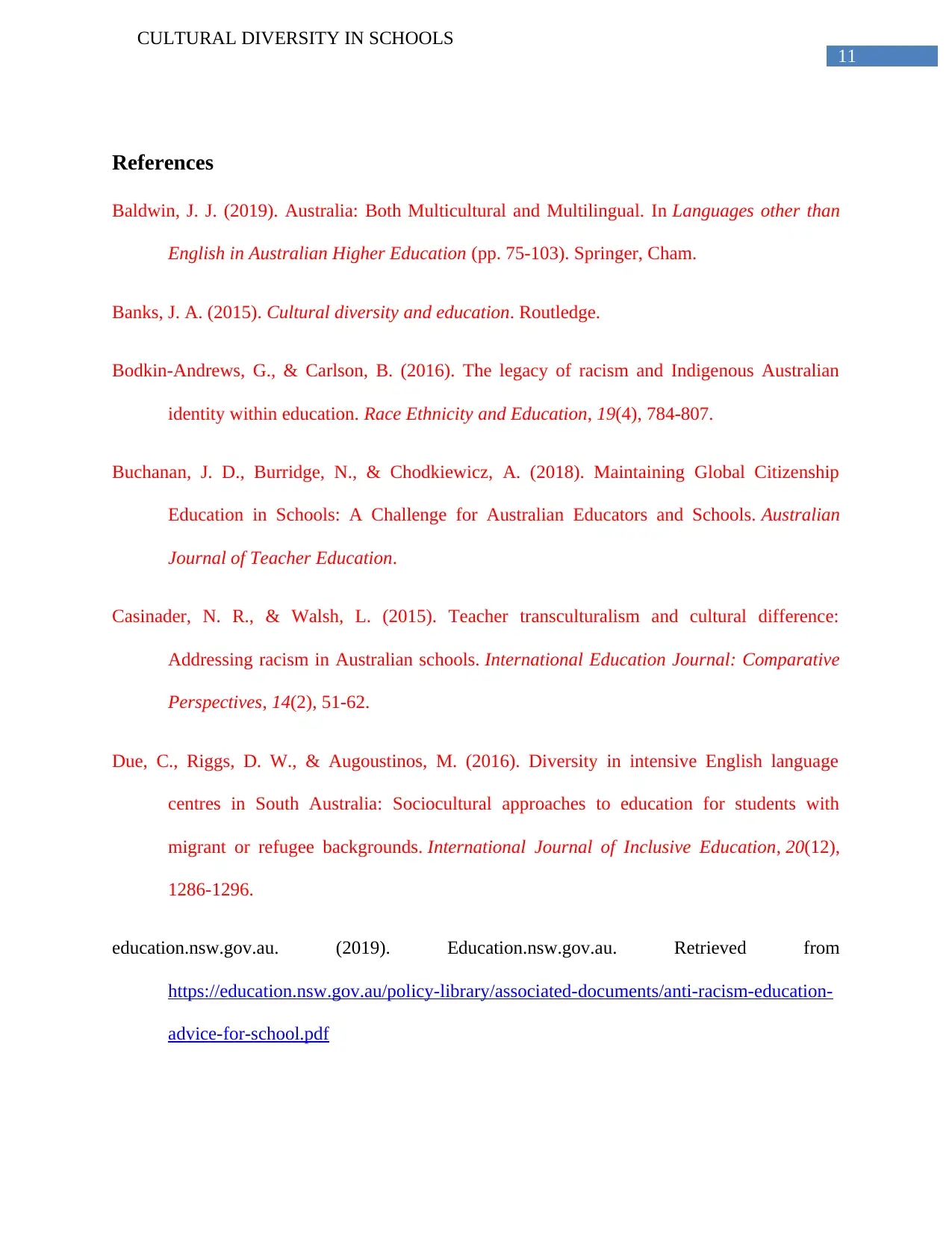
11
CULTURAL DIVERSITY IN SCHOOLS
References
Baldwin, J. J. (2019). Australia: Both Multicultural and Multilingual. In Languages other than
English in Australian Higher Education (pp. 75-103). Springer, Cham.
Banks, J. A. (2015). Cultural diversity and education. Routledge.
Bodkin-Andrews, G., & Carlson, B. (2016). The legacy of racism and Indigenous Australian
identity within education. Race Ethnicity and Education, 19(4), 784-807.
Buchanan, J. D., Burridge, N., & Chodkiewicz, A. (2018). Maintaining Global Citizenship
Education in Schools: A Challenge for Australian Educators and Schools. Australian
Journal of Teacher Education.
Casinader, N. R., & Walsh, L. (2015). Teacher transculturalism and cultural difference:
Addressing racism in Australian schools. International Education Journal: Comparative
Perspectives, 14(2), 51-62.
Due, C., Riggs, D. W., & Augoustinos, M. (2016). Diversity in intensive English language
centres in South Australia: Sociocultural approaches to education for students with
migrant or refugee backgrounds. International Journal of Inclusive Education, 20(12),
1286-1296.
education.nsw.gov.au. (2019). Education.nsw.gov.au. Retrieved from
https://education.nsw.gov.au/policy-library/associated-documents/anti-racism-education-
advice-for-school.pdf
CULTURAL DIVERSITY IN SCHOOLS
References
Baldwin, J. J. (2019). Australia: Both Multicultural and Multilingual. In Languages other than
English in Australian Higher Education (pp. 75-103). Springer, Cham.
Banks, J. A. (2015). Cultural diversity and education. Routledge.
Bodkin-Andrews, G., & Carlson, B. (2016). The legacy of racism and Indigenous Australian
identity within education. Race Ethnicity and Education, 19(4), 784-807.
Buchanan, J. D., Burridge, N., & Chodkiewicz, A. (2018). Maintaining Global Citizenship
Education in Schools: A Challenge for Australian Educators and Schools. Australian
Journal of Teacher Education.
Casinader, N. R., & Walsh, L. (2015). Teacher transculturalism and cultural difference:
Addressing racism in Australian schools. International Education Journal: Comparative
Perspectives, 14(2), 51-62.
Due, C., Riggs, D. W., & Augoustinos, M. (2016). Diversity in intensive English language
centres in South Australia: Sociocultural approaches to education for students with
migrant or refugee backgrounds. International Journal of Inclusive Education, 20(12),
1286-1296.
education.nsw.gov.au. (2019). Education.nsw.gov.au. Retrieved from
https://education.nsw.gov.au/policy-library/associated-documents/anti-racism-education-
advice-for-school.pdf
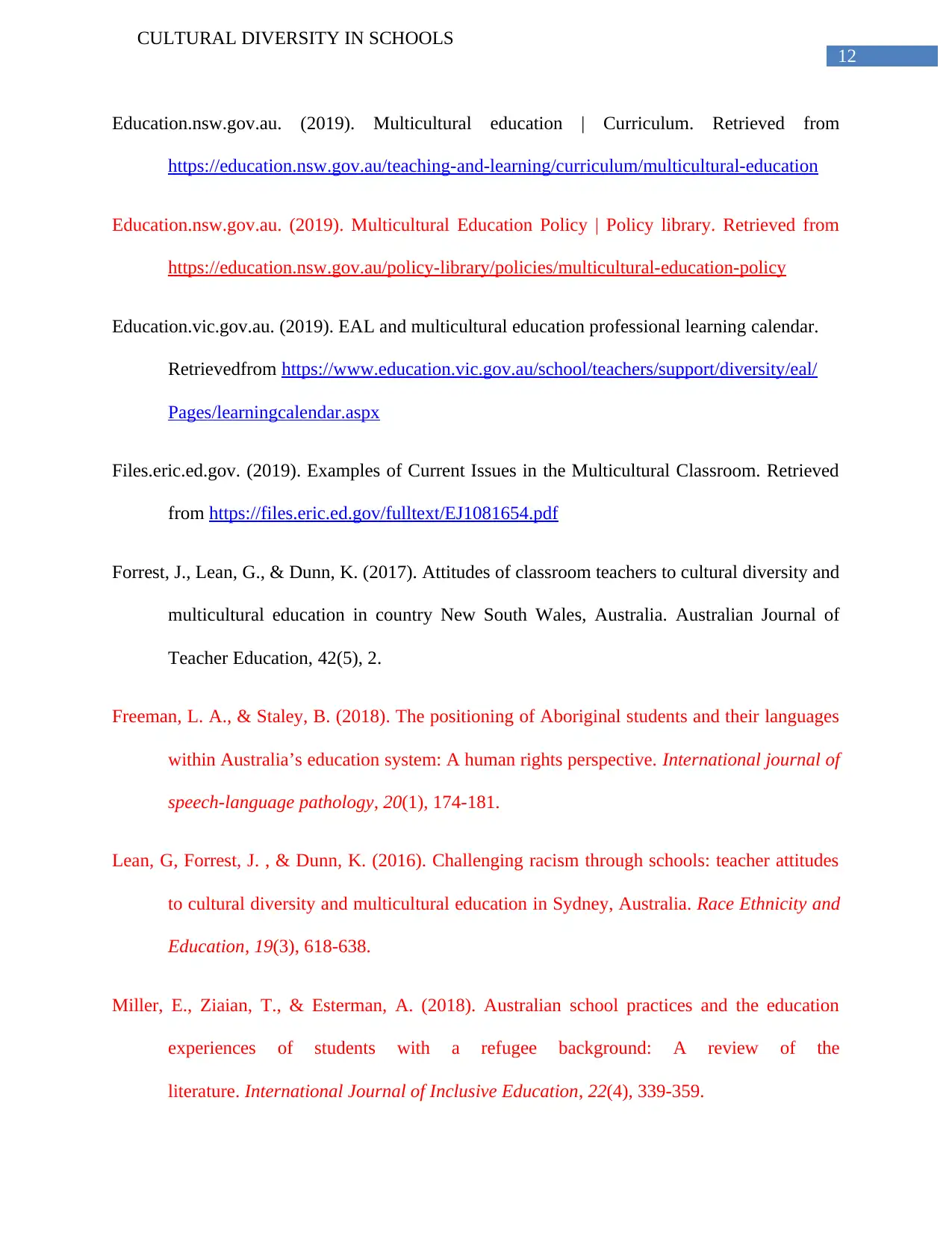
12
CULTURAL DIVERSITY IN SCHOOLS
Education.nsw.gov.au. (2019). Multicultural education | Curriculum. Retrieved from
https://education.nsw.gov.au/teaching-and-learning/curriculum/multicultural-education
Education.nsw.gov.au. (2019). Multicultural Education Policy | Policy library. Retrieved from
https://education.nsw.gov.au/policy-library/policies/multicultural-education-policy
Education.vic.gov.au. (2019). EAL and multicultural education professional learning calendar.
Retrievedfrom https://www.education.vic.gov.au/school/teachers/support/diversity/eal/
Pages/learningcalendar.aspx
Files.eric.ed.gov. (2019). Examples of Current Issues in the Multicultural Classroom. Retrieved
from https://files.eric.ed.gov/fulltext/EJ1081654.pdf
Forrest, J., Lean, G., & Dunn, K. (2017). Attitudes of classroom teachers to cultural diversity and
multicultural education in country New South Wales, Australia. Australian Journal of
Teacher Education, 42(5), 2.
Freeman, L. A., & Staley, B. (2018). The positioning of Aboriginal students and their languages
within Australia’s education system: A human rights perspective. International journal of
speech-language pathology, 20(1), 174-181.
Lean, G, Forrest, J. , & Dunn, K. (2016). Challenging racism through schools: teacher attitudes
to cultural diversity and multicultural education in Sydney, Australia. Race Ethnicity and
Education, 19(3), 618-638.
Miller, E., Ziaian, T., & Esterman, A. (2018). Australian school practices and the education
experiences of students with a refugee background: A review of the
literature. International Journal of Inclusive Education, 22(4), 339-359.
CULTURAL DIVERSITY IN SCHOOLS
Education.nsw.gov.au. (2019). Multicultural education | Curriculum. Retrieved from
https://education.nsw.gov.au/teaching-and-learning/curriculum/multicultural-education
Education.nsw.gov.au. (2019). Multicultural Education Policy | Policy library. Retrieved from
https://education.nsw.gov.au/policy-library/policies/multicultural-education-policy
Education.vic.gov.au. (2019). EAL and multicultural education professional learning calendar.
Retrievedfrom https://www.education.vic.gov.au/school/teachers/support/diversity/eal/
Pages/learningcalendar.aspx
Files.eric.ed.gov. (2019). Examples of Current Issues in the Multicultural Classroom. Retrieved
from https://files.eric.ed.gov/fulltext/EJ1081654.pdf
Forrest, J., Lean, G., & Dunn, K. (2017). Attitudes of classroom teachers to cultural diversity and
multicultural education in country New South Wales, Australia. Australian Journal of
Teacher Education, 42(5), 2.
Freeman, L. A., & Staley, B. (2018). The positioning of Aboriginal students and their languages
within Australia’s education system: A human rights perspective. International journal of
speech-language pathology, 20(1), 174-181.
Lean, G, Forrest, J. , & Dunn, K. (2016). Challenging racism through schools: teacher attitudes
to cultural diversity and multicultural education in Sydney, Australia. Race Ethnicity and
Education, 19(3), 618-638.
Miller, E., Ziaian, T., & Esterman, A. (2018). Australian school practices and the education
experiences of students with a refugee background: A review of the
literature. International Journal of Inclusive Education, 22(4), 339-359.
Paraphrase This Document
Need a fresh take? Get an instant paraphrase of this document with our AI Paraphraser
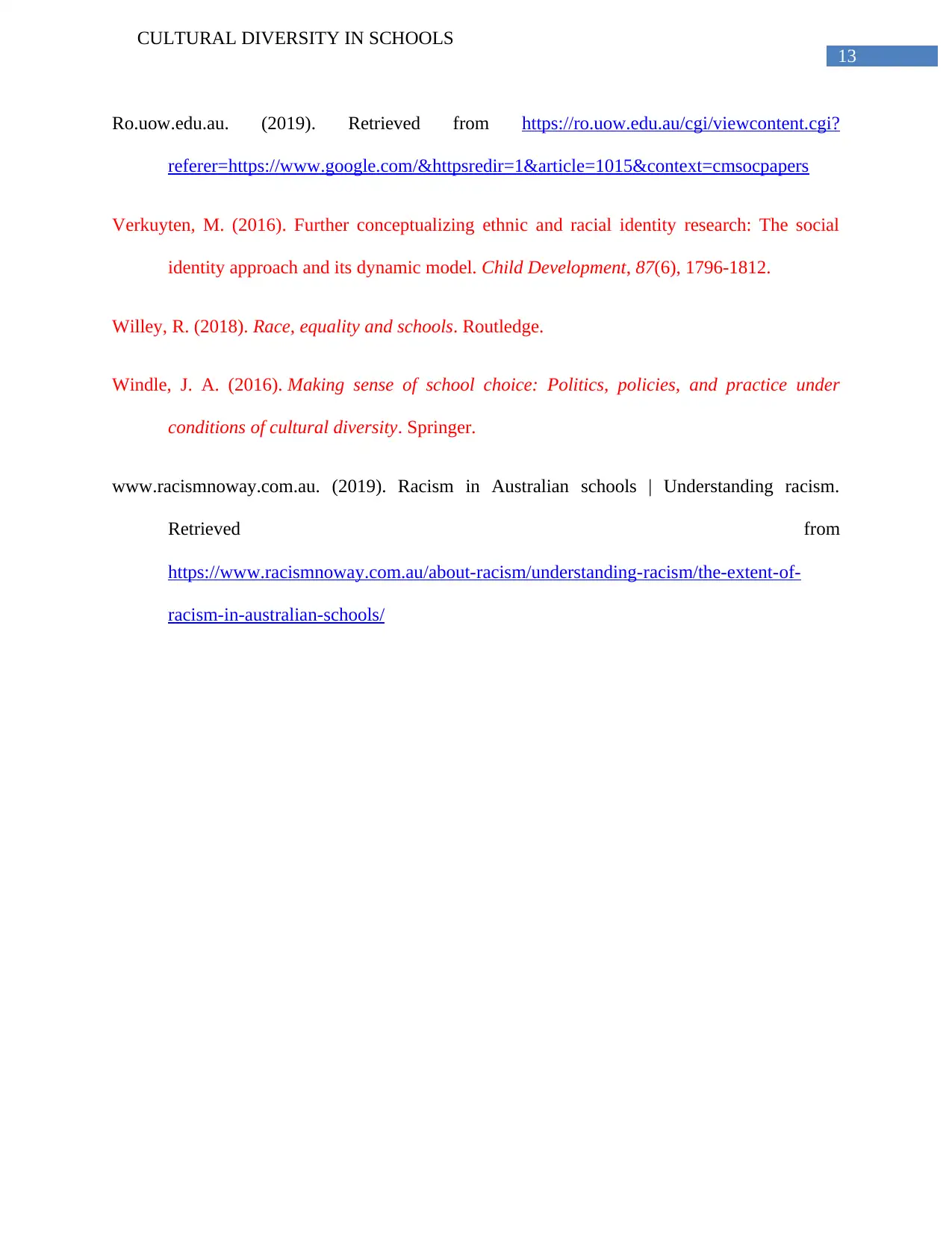
13
CULTURAL DIVERSITY IN SCHOOLS
Ro.uow.edu.au. (2019). Retrieved from https://ro.uow.edu.au/cgi/viewcontent.cgi?
referer=https://www.google.com/&httpsredir=1&article=1015&context=cmsocpapers
Verkuyten, M. (2016). Further conceptualizing ethnic and racial identity research: The social
identity approach and its dynamic model. Child Development, 87(6), 1796-1812.
Willey, R. (2018). Race, equality and schools. Routledge.
Windle, J. A. (2016). Making sense of school choice: Politics, policies, and practice under
conditions of cultural diversity. Springer.
www.racismnoway.com.au. (2019). Racism in Australian schools | Understanding racism.
Retrieved from
https://www.racismnoway.com.au/about-racism/understanding-racism/the-extent-of-
racism-in-australian-schools/
CULTURAL DIVERSITY IN SCHOOLS
Ro.uow.edu.au. (2019). Retrieved from https://ro.uow.edu.au/cgi/viewcontent.cgi?
referer=https://www.google.com/&httpsredir=1&article=1015&context=cmsocpapers
Verkuyten, M. (2016). Further conceptualizing ethnic and racial identity research: The social
identity approach and its dynamic model. Child Development, 87(6), 1796-1812.
Willey, R. (2018). Race, equality and schools. Routledge.
Windle, J. A. (2016). Making sense of school choice: Politics, policies, and practice under
conditions of cultural diversity. Springer.
www.racismnoway.com.au. (2019). Racism in Australian schools | Understanding racism.
Retrieved from
https://www.racismnoway.com.au/about-racism/understanding-racism/the-extent-of-
racism-in-australian-schools/
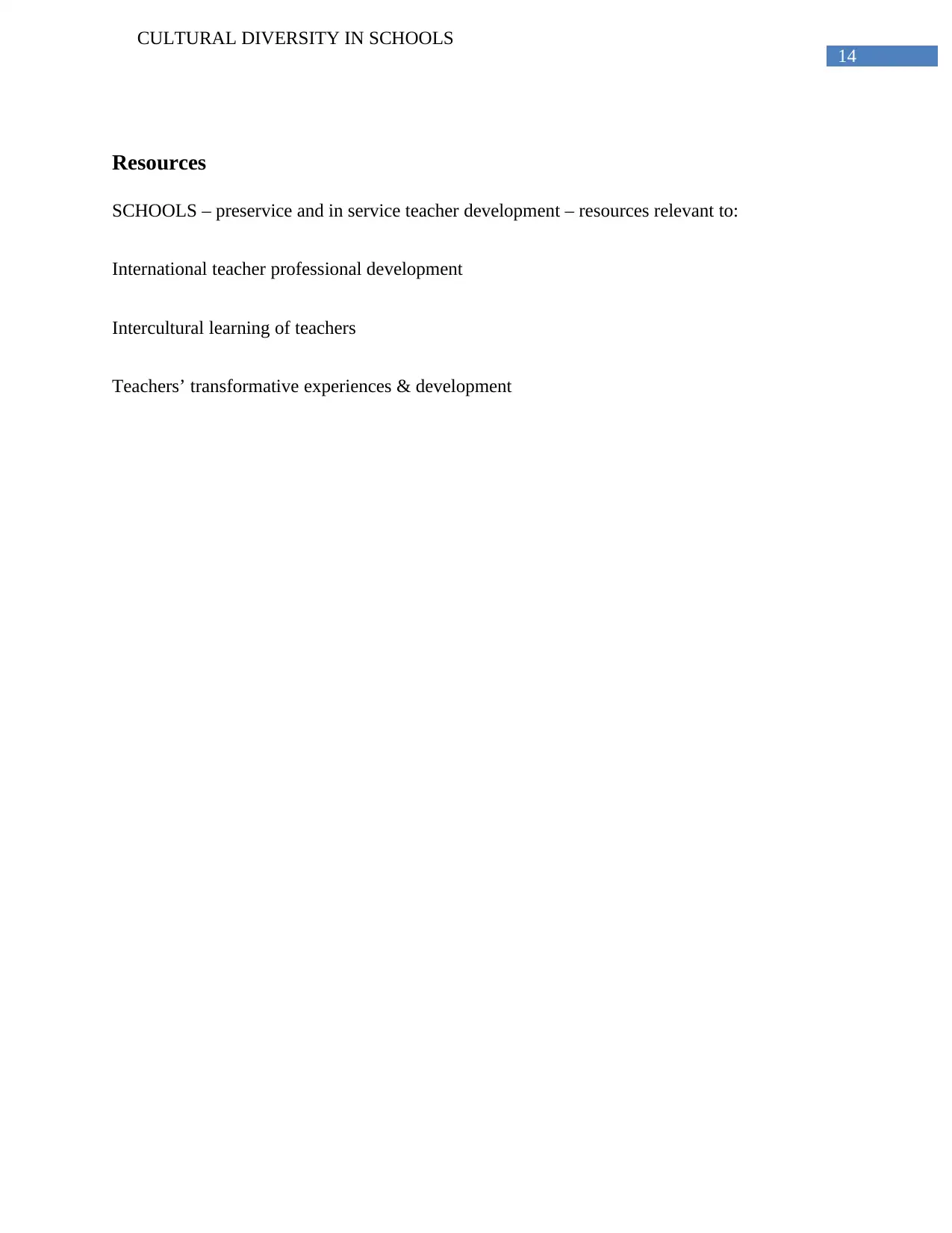
14
CULTURAL DIVERSITY IN SCHOOLS
Resources
SCHOOLS – preservice and in service teacher development – resources relevant to:
International teacher professional development
Intercultural learning of teachers
Teachers’ transformative experiences & development
CULTURAL DIVERSITY IN SCHOOLS
Resources
SCHOOLS – preservice and in service teacher development – resources relevant to:
International teacher professional development
Intercultural learning of teachers
Teachers’ transformative experiences & development
1 out of 15
Related Documents
Your All-in-One AI-Powered Toolkit for Academic Success.
+13062052269
info@desklib.com
Available 24*7 on WhatsApp / Email
![[object Object]](/_next/static/media/star-bottom.7253800d.svg)
Unlock your academic potential
© 2024 | Zucol Services PVT LTD | All rights reserved.





